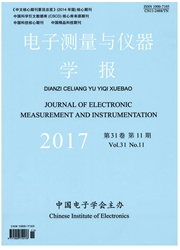

 中文摘要:
中文摘要:
针对传统模态测试方法存在获取信息有限和附加质量、已有非接触模态测试方法需进行复杂图像处理等问题,提出了光流点匹配跟踪的薄壁件振动模态测试方法,避免了需逐帧进行特征分割、提取等复杂的图像处理。首先,建立了面内振动视觉测量的成像模型,通过相机标定获取工业相机的内、外参数并进行了误差分析。研究了基于光流视觉测振的原理与方法,该方法通过单目相机采集带特征点的结构振动序列图像,运用金字塔的Lucas-Kanada算法进行光流点匹配跟踪,进而获得亚像素级特征点的振动信息,在此基础上进行模态参数辨识获得模态参数。基于提出的方法搭建了薄壁件振动模态测试系统,对薄壁梁进行了振动模态测试实验,并与激振器扫频测试结果和有限元仿真结果进行了对比分析。实验结果表明,固有频率误差在5%以内,模态振型一致,从而验证了提出方法的正确性,为薄壁件的振动模态测试提供了新方法。
 英文摘要:
英文摘要:
Aiming at overcoming the problems that the traditional modal testing methods have limited information and the transducer additional mass effects modal parameters,and existing non-contact modal testing method requires complex image processing,a vibration modal measurement method for thin-walled parts using optical flow point matching and tracking is proposed. It avoids complicated image processing such as feature segmentation and extraction and so on in each frame. Firstly,the model of vibration detection based on the inplane vision is developed. The intrinsic and extrinsic parameters of industrial camera are calibrated through the camera calibration board,and the errors are analyzed. The principle and the method of monocular vision vibration testing based on optical flow method are investigated. The vibrating sequence images of structure which has pasted feature points are captured with a monocular industrial camera.The pyramid Lucas-Kanada algorithm is used for optical flow point matching and tracking,and to get the vibration information of each sub-pixel feature point. And then the modal parameters are obtained by modal parameter identification. Based on the proposed method,a thin-walled vibration modal testing system is built and the vibration modal testing experiments with the thin-walled beam is investigated,the testing results are compared and analyzed between that of a shaker testing and FEM simulation. The results show that the natural frequency errors are less than 5% and the corresponding vibration modes are the same,which verifies the correctness of the proposed method,so the proposed method provides a new way for the vibration modal testing of thin-walled parts.
 同期刊论文项目
同期刊论文项目
 同项目期刊论文
同项目期刊论文
 期刊信息
期刊信息
